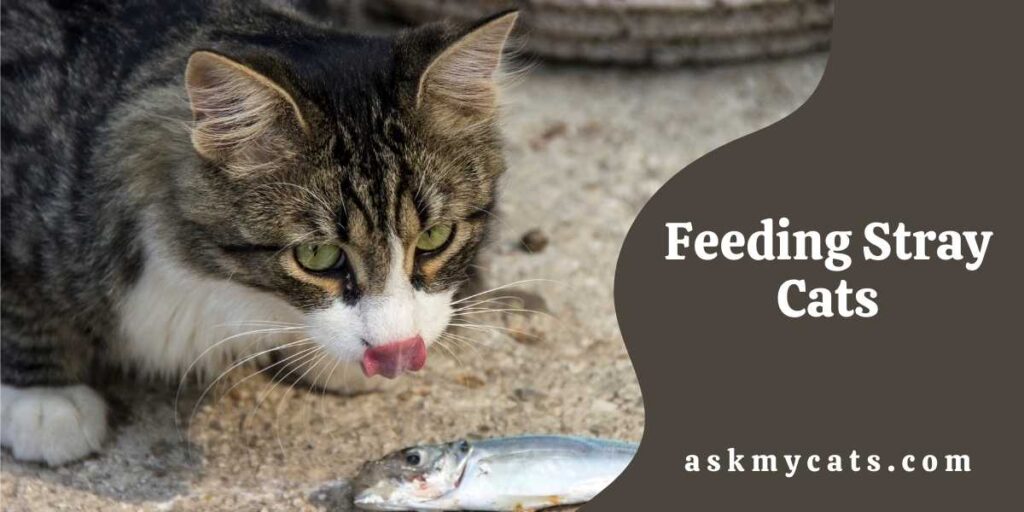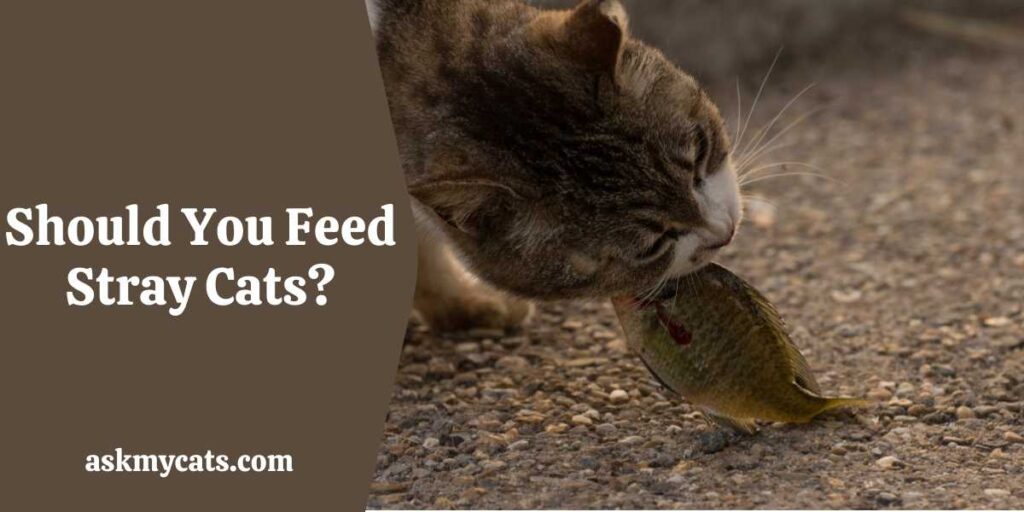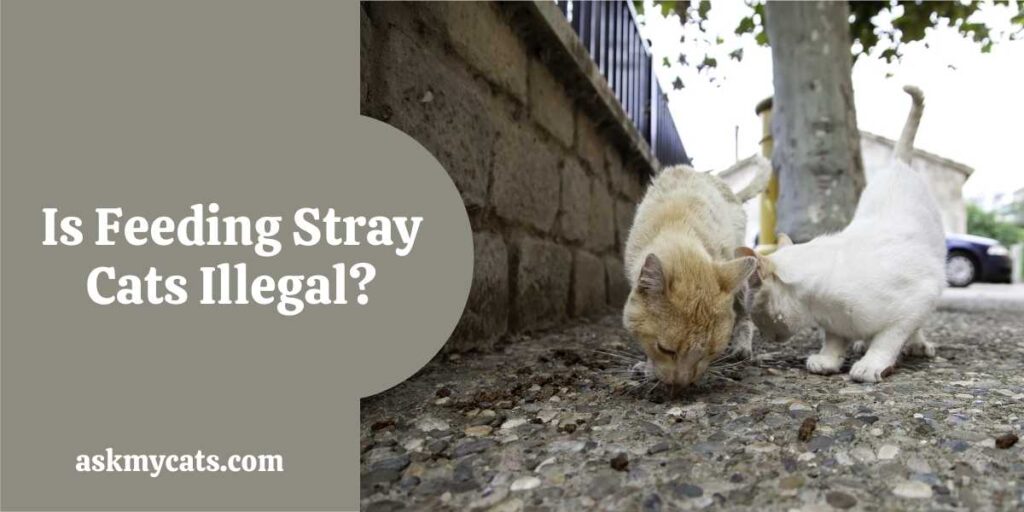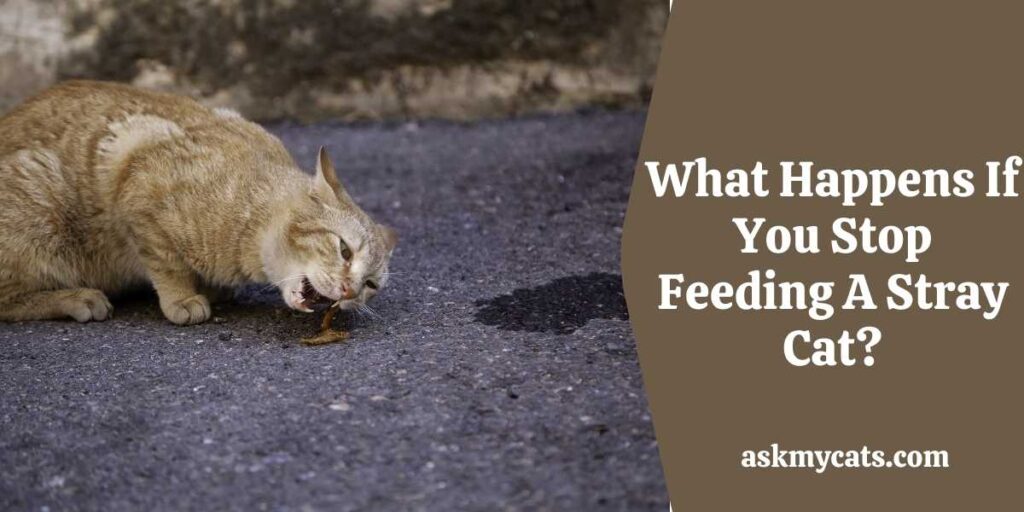It’s fantastic that you wish to assist stray animals in your community!
Many stray cats are underweight and unwell due to an abundance of street animals and a lack of food to feed them all. You can help them stay healthy by providing them with a consistent source of proper food.
Providing food for stray cats allows them to live a somewhat more comfortable existence. However, doing so will increase the number of stray animals in the area, resulting in more starved strays. Their hunting impulses will deplete the animal population in the area. Strays are also known to bring infections that are hazardous to both home pets and people.
Any animal lover worth their salt would go to the pantry for some chow or tuna fish. Is it, however, in the best interests of the cat and your community to feed a wild cat?


Give Your Cat the Perfect Day
Get the Free Ebook!
Should You Feed Stray Cats?
You should feed stray cats by maintaining proper hygiene so that you do not get contaminated by infections.

Feeding stray animals is instinctively the correct thing to do. All cats, regardless of whether they have a home or not, require affection.
Strays have a lot to cope with while they’re out in the wild. Strays face a difficult existence, from traffic to territorial clashes with other cats.
Many animal welfare activists advise against feeding strays, which may come as a surprise. This is because, even though it appears to be the proper thing to do, there are repercussions to this behaviour.
According to some estimates, there are as many as 100 million feral cats in the United States.
They are mainly the offspring of abandoned or lost pets that have become wild animals with no human interaction and rely on scavenging to survive.
They eventually form colonies wherever they can find food and shelter.
Cats kill nearly 2.4 billion birds and 12.3 billion animals per year, according to one research published in the journal Nature Communications, significantly more than previously estimated.
Although many cat advocates questioned how those estimates were generated, no one can deny that cats are hunters and that wildlife is frequently harmed as a result.
Is Feeding Stray Cats Illegal?
The regulations governing the feeding of stray animals vary depending on where you reside. Feeding strays is prohibited in several parts of the United States, and you might face jail time or a fine. Check your local regulations before feeding a stray.

The majority of individuals believe that feeding stray animals is a good gesture. It’s true in many ways since you’re assisting a hungry cat in surviving.
Feeding a stray, on the other hand, isn’t always a good idea. There are several reasons why you should not feed them, and even animal welfare organizations and vets advise against it.
Dangers Of Feeding Stray Cats
Giving food to stray animals entails a number of risks, including:
1. Boost The Population
The biggest problem is that feeding strays expand their population. The more you feed them, the faster they’ll grow. Each year, adult females have roughly 2-3 litters.
According to estimates, a single adult female cat and her kittens may generate up to 420,000 cats over the course of seven years. That means you’re compounding the problem by adding to the number of wild cats that need to be cared for.
2. Spreading Illness
The lives of stray cats are difficult. They have to avoid autos, enraged homeowners with poisons, and predators. It’s pretty uncommon for them to just live a few years because of all the threats.
Feral cats are prone to sickness and illness, and are commonly infested with parasites. They may be flea-infested or infected with rabies when they appear on your porch.
Fleas can cause tapeworm infection and even the plague in rare situations. Cats can also transmit rabies and other infections.
If you’re feeding stray cats, crush over-the-counter Capstar flea control tablets and mix them in with their food. It eliminates fleas quickly and is suitable for kittens as young as four weeks old.
3. Affects Local Wildlife
Free-roaming cat populations have a terrible impact on local fauna. Stray cats kill an estimated 1.3-4 million birds and 6.3-22.3 billion animals in the United States each year, according to Nature Communications.
Researchers have concluded that feral cats are responsible for at least 14% of worldwide bird, mammal, and reptile extinctions, according to Global Change Biology.
Wildlife populations in the area will not just dwindle. They could potentially be hunted to extinction. Feral cats are also the primary threat to 8% of highly endangered birds, animals, and reptiles, according to experts.
Of course, these cats aren’t all stray. Although some of them are tamed, they are permitted to roam freely outside. Nonetheless, the bulk of deaths are caused by unowned cats, according to the study.
4. Trouble Neighbors
You’d want to feed stray cats, but your neighbours are opposed. It’s possible that there’s a valid explanation for this.
Diseases, wildlife harm, and an increase in the number of strays in the region can all put a stop to entire towns feeding them. Strays may also be noisy and destructive, digging up yards and causing injury to domestic pets.
Feeding stray animals encourages them to return. They, like other species (even wild or feral animals), prefer a simple diet than one that requires hunting.
Stray cats will very probably return if there is a consistent source of food. This can result in their developing colonies near your home and overflowing onto your neighbour’s yard.
Benefits of Feeding Stray Cats
The benefits of feeding stray cats are as follows:
- Feeding feral cats can help them to survive in the short run
- Feeding stray cats may give you a good feeling
- You may be able to protect other animals
- You may do your kids a favor by feeding stray cats
- You can reduce your food waste
- Can be helpful if you need company
- You can learn about nature
- Can help to reduce populations of mice in your neighborhood
- Stray cats will really appreciate what you do for them
- You may be able to adopt a stray cat
- You can encourage others to adopt stray cats or shelter animals
What Happens If You Stop Feeding A Stray Cat?
If you stop feeding the cats, they will likely stay in the same area but be forced to expand their search for food.

If you stop feeding a stray cat completely, it may return in the days and weeks ahead. When it recognises there won’t be any more food, it’ll look for new, more trustworthy food sources.
Cats normally establish a territory and stay in it for the rest of their lives. It may be compelled to hunt or seek out other humans for food. However, the cat is likely to seek out other food sources around you.
If You Feed a Stray Cat Will It Stay?
Yes, stray cats will stay or come for food if you feed them.
Recognize that if you feed a stray cat, it will return in search of food. Cats are wired in this manner. The longer you feed the animal, the more it will grow reliant on you for its existence.
Also, keep in mind that feeding one stray cat invites other strays and wild cats in the neighbourhood to join in. Not only will the initial cat return for more food, but it will also bring along additional hungry cats.
You may start with just one cat and wind up with a half-dozen or more relying on you for sustenance. Don’t be shocked if they decide to make their home on your land.
Cats are territorial animals who are hesitant to leave their territory. If there isn’t enough food to go around, they’ll have to leave to survive. Otherwise, they will remain in the same region for the rest of their lives.
Be prepared to be in it for the long haul if you are keeping a stray alive by feeding it. It has no intention of leaving anytime soon.
Frequently Asked Questions
How Much Should I Feed Stray Cats?
Adult cats require 5.5 ounces of wet food or 2 ounces of dry food each day. Because of its flavour and water content, wet food is more appealing with cats. Dry food, on the other hand, can be just as nourishing. It’s also less difficult to store.
What Do You Feed Stray Cats?
Whether it’s a stray or not, cat food is the finest dinner. If you have cat food on hand, you can give it to a homeless cat without risk. Carbohydrates, while not ideal, are a decent method to bulk out a stray’s diet. Cats are obligate carnivores, meaning they can’t metabolise anything other than meat. However, eating veggies is preferable to eating nothing at all.
Will A Stray Cat Starve If I Stop Feeding It?
You may need to discontinue feeding a stray cat at times. Maybe you don’t have any food to provide, or you’re relocating and are concerned about the animal’s well-being. The good news is that the wandering cat will be okay. If you stop feeding the cat, these clever creatures will locate food elsewhere.
Final Words
Although feeding stray cats is a kind thing to do, it is often discouraged. This is because stray cats require medical attention and should be examined and treated by a veterinarian to guarantee they are not disease carriers.
The greatest thing you can do for stray cats is to notify your local animal rescue agencies so that they may be part of a TNR programme for felines.
Drop your questions in the comments section below.

Two other ladies were feeding at times taking in some of the homeless cats and kittens when I moved in Moble home for many years one moved then the other now it’s just me some are friendly some feryal about four are sick now I have been told if I don’t stop feeding them I will be evicted from park I can’t afford to move my Moble home .most are healthy I flea the ones I can pet .I can’t bare even walking out side because they are there hungry and confused iam sure .what do I do ?
It sounds like you are in a difficult situation. Feeding stray cats can be a kind and compassionate thing to do, but it can also lead to problems if not done responsibly. If the cats you are feeding are causing issues for the other residents of the mobile home park, the park owner has the right to ask you to stop feeding them.
If you are unable to find homes for the cats or afford to move your mobile home, one option may be to contact a local animal shelter or rescue group to see if they can provide assistance. These organizations often have programs in place to help feed and care for stray and homeless cats, and may be able to help you find a solution to the situation.
Another option is to try to gradually wean the cats off of being fed by you. This can be done by slowly reducing the amount of food you provide, and encouraging the cats to find food elsewhere. This may take some time, and you may need to continue providing some food until the cats are able to fend for themselves.
Ultimately, the decision is up to you, but it’s important to consider the potential consequences of continuing to feed the cats if it could lead to you being evicted from your home. It may be best to seek help from a local animal organization to find a solution that is safe and responsible for both you and the cats.
The women across the street from me keeps feeding 2 stray and intact toms causing them to take up residence around my house. This created a problem for me because these 2 toms keep coming to my yard and terrorizing my own cats. Mine are spayed females and for some reason those cats insist on bullying my cats. Two of the fights they’ve had resulted in visits to the vet for swollen abscesses. I’ve asked her to stop feeding them after explaining the situation, let’s see if she listens. If not, I’ll do whatever has to be done even if it means killing the strays. I’m sure it’s not just my cats they bully, but the entire neighbourhood pet cats. It’s so inconsiderate of the of everyone around her. If she wants to keep them, she should trap and sterilize them! If they end up being injured because I took matters into my own hands, that’s her own fault.
I’m really sorry to hear about the trouble you’re experiencing with the stray toms and the impact they’re having on your cats. It’s understandable that you’re frustrated and concerned about the situation. Dealing with territorial disputes between cats can be challenging and can sometimes lead to injuries.
While it’s important to address the issue and protect your own cats, I would encourage you to consider alternative solutions before resorting to extreme measures. Killing the strays may not be the best course of action, as it could lead to further complications and potential legal consequences.
Have you considered talking to your neighbor again and emphasizing the severity of the situation? Perhaps you could discuss the option of trapping and sterilizing the stray toms to prevent further breeding and territorial behavior. This approach could help in reducing their aggression and potentially minimize their impact on the neighborhood cats.
Additionally, you might want to explore other methods to deter the stray toms from entering your property, such as using motion-activated deterrents or fencing off certain areas. Providing a safe and secure environment for your own cats is crucial to their well-being.
Remember, it’s important to prioritize the safety of all animals involved and find a resolution that benefits everyone. If the situation persists despite your efforts, you could consider reaching out to local animal control or a community organization that deals with stray animals for further assistance.
I hope you find a solution that brings peace and harmony to your neighborhood and keeps all the cats safe.